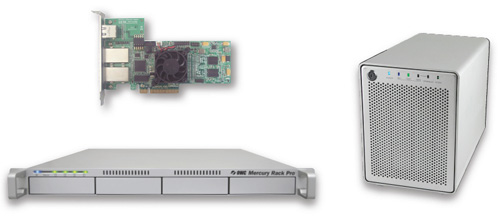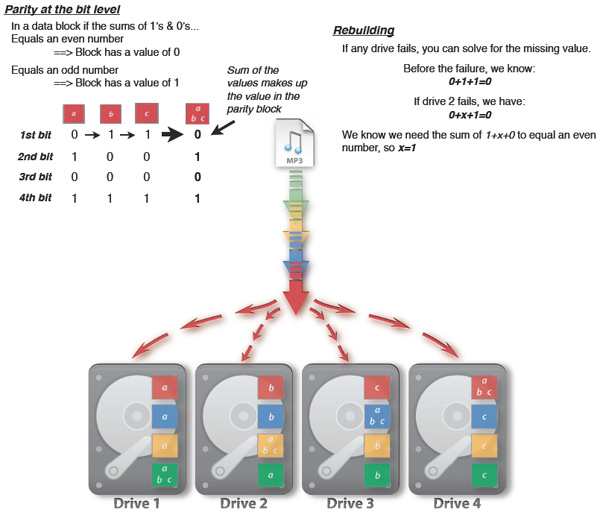RAID 5 "Stripe with Parity"
Speed, Large Storage, & Redundancy.
- 3 or more drives
- RAID array shows up as a single volume on the desktop.
Perfect For
Anyone wanting the speed and large capacity of striping, but with the protection of mirroring.- Store music, photos, videos
- Anything that takes time to create
- Anything that is difficult to replace
- Anyone needing faster data rates
Speed & Protection
With RAID 5, data is striped for speed like a RAID 0, but a duplication or parity is built in to protect your data from a single drive failure. This results in fast performance comparable to a RAID 0, but with the added benefit of protection.Optimized Storage Space
The storage space resulting from a RAID 5 array is:
the sum of all the drives put together minus one drive worth of space.


How the Data is Distributed
RAID 5 incorporates striping of data just like in a RAID 0 array, however, in a RAID 5 there are redundant pieces of the data that are also distributed across the drives and are referred to as parity. Having the parity blocks staggered across each drive allows any single drive in the RAID 5 array to fail without any data loss.
In the illustration below there are 4 drives set up as a RAID 5.
Each colored square is a "block" of data. All blocks are the same size.
- The first data block of the mp3 file is represented as:

- The second data block is represented as:

- And the third data block is represented as:


Learn More About the Types of RAID
RAID 0 (Stripe)
Data is split into blocks over two or more drives at same time for high speed and large capacity.
Capacity

Data Safety

Performance

RAID 1 (Mirror)
Data is written at same time to two drives only for highest level of data safety and redundancy.
Capacity

Data Safety

Performance

RAID 10 (1+0)
Data is Striped (RAID 0) over two Mirrored sets (RAID 1) of drives for fast redundancy.
Capacity

Data Safety

Performance

RAID 5 (Stripe with Parity)
Data is Striped (RAID 0) while incorporating parity over three or more drives for the best combination of speed, capacity, and redundancy.
Capacity

Data Safety

Performance

JBOD
(Just a Bunch Of Disks/Drives)
Each disk shows up as an individual logical volume on the computer. A 4 bay unit populated with drives will have 4 logical drives show up on the computer.
Capacity

Data Safety

Performance

Span (N-RAID)
Combines capacity of two or more drives of varying size without any RAID data distribution scheme into one logical desktop volume.
Capacity

Data Safety

Performance

